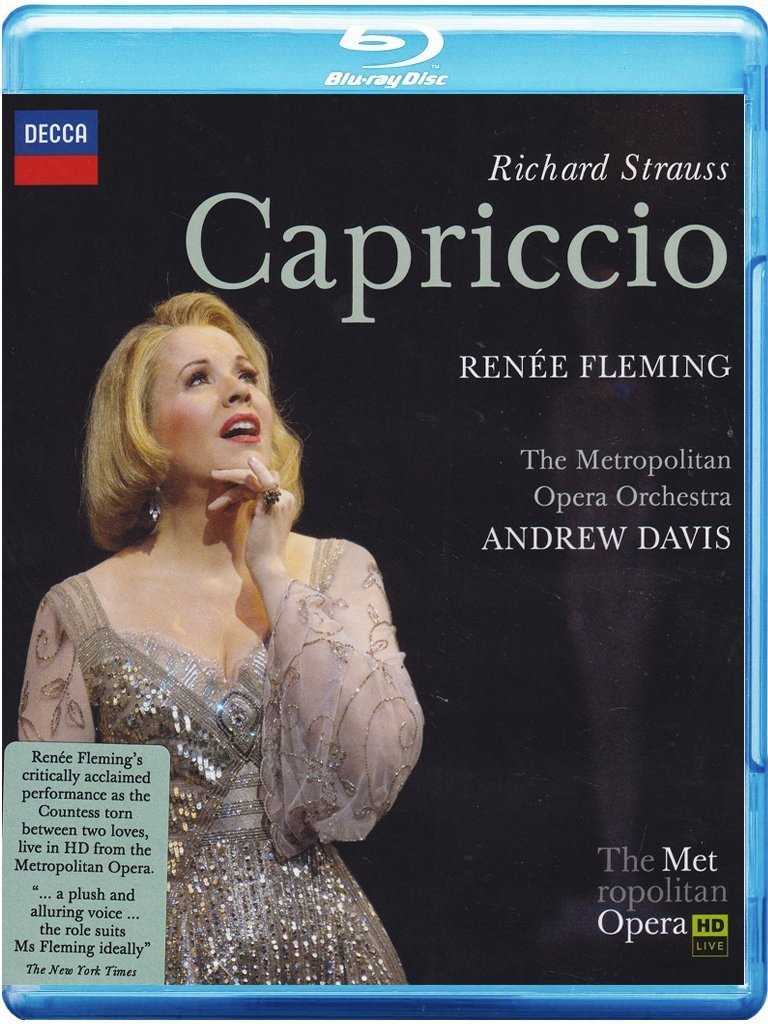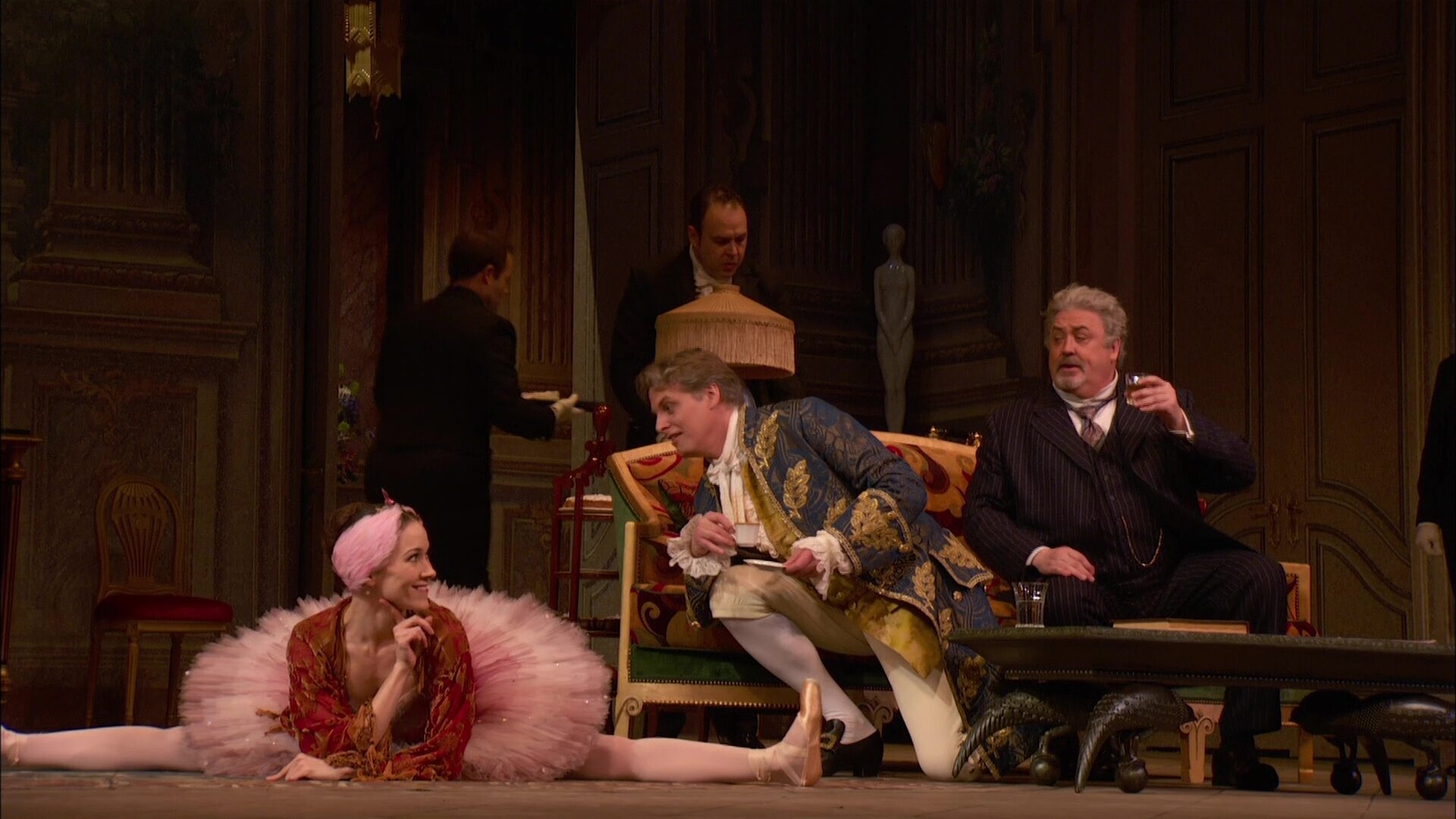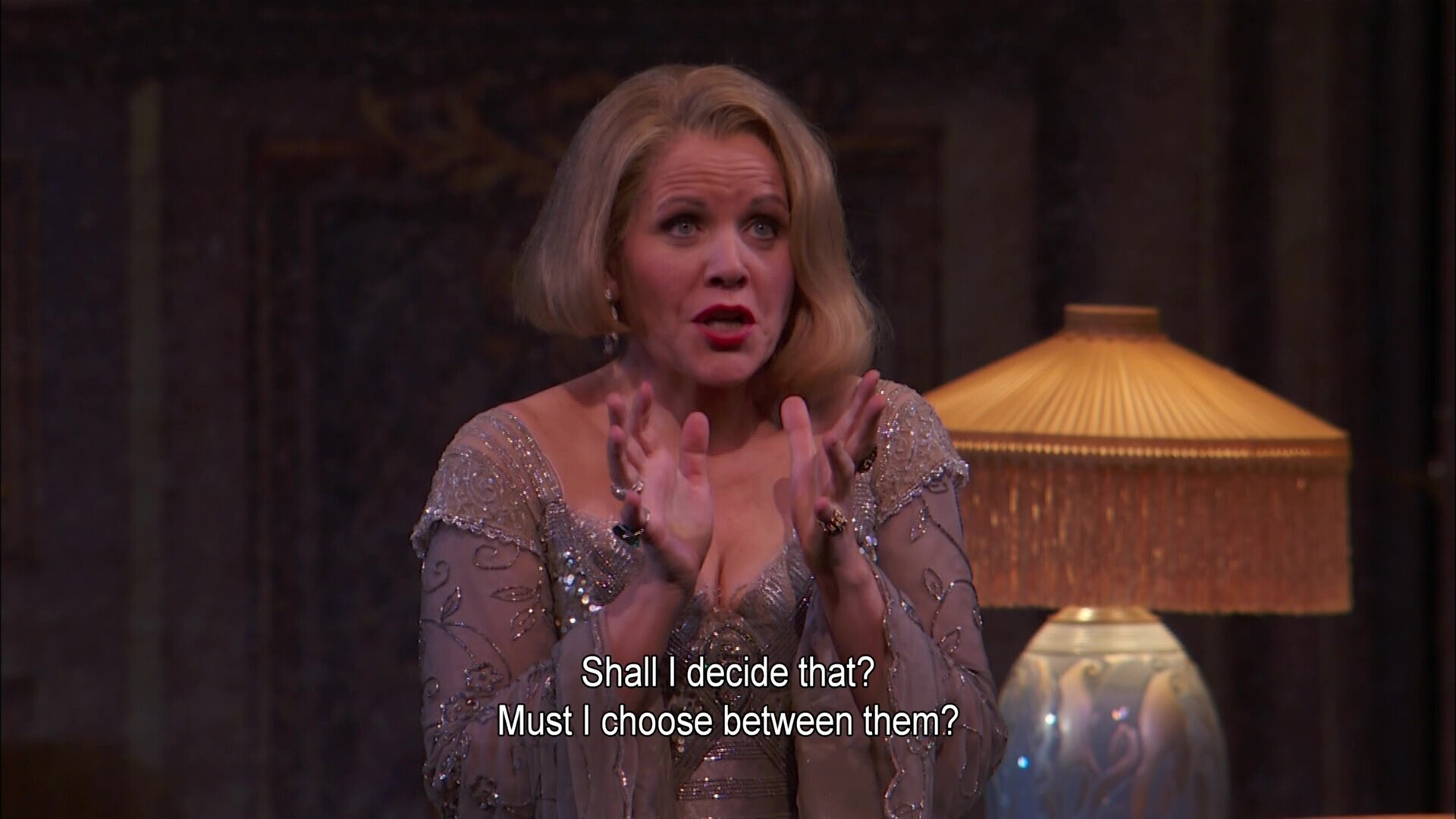

Richard Strauss Capriccio opera to a libretto by Clemens Krauss and Richard Strauss. This is the Met John Cox production with 2011 stage direction by Peter McClintock. Stars Renée Fleming (The Countess), Joseph Kaiser (Flamand), Russell Braun (Olivier), Peter Rose (La Roche), Morten Frank Larsen (The Count), Sarah Connolly (Clairon), Olga Makarina and Barry Banks (Italian Singers), Ronald Naldi, Paul Corona, Steven Goldstein, Christopher Schaldenbrand, Grant Youngblood, Scott Scully, Brian Frutiger, Kyle Pfortmiller (Servants), Micahael Devlin (Majordomo), and Bernard Fitch (Monsieur Taupe). Solo dancers are Laura Feig and Eric Otto. Also stars stage musicians David Chan (violin), Rafael Figueroa (cello), and Dennis Giauque (harpsichord). Andrew Davis conducts the Metropolitan Opera Orchestra, with stage band conductor Jeffrey Goldberg. Set design by Mauro Pagano; costume design and interior décor by Robert Perdziola; lighting design by Duane Schuler; choreography by Val Caniparoli; dramaturgy by Paul Cremo. Directed for TV by Gary Halvorson; music producer was Jay David Saks. Supervising Producers were Mia Bongiovanni and Elena Park; Producers were Louisa Briccetti and Victoria Warivonchik. Released 2011, disc has 5.1 dts-HD Master Audio sound. Grade: A+
Richard Strauss was the last great, complete man of music in the western tradition: an expert musician, famous orchestra conductor, and composer of music in many genre including 17 complete operas. He kept working until his death at age 85 and is considered the greatest octogenarian composer ever. Strauss sought literary geniuses to write his opera librettos. The words for all his most popular operas were written by Oscar Wilde (Salome) or Hugo von Hofmansthal (Arabella, Ariadne auf Naxos, Elektra, Frau ohne Schatten, and Rosenkavalier). When it came time to write Capriccio, which Strauss called a “conversation piece” about music, there was no literary giant available. But Clemens Krauss, a conductor and opera impresario, brilliantly stepped into the breach. If you had to translate “Capriccio” into English the name of the opera might be “Whimsy.” So why not start the opera off with a 7-minute string sextet of 2 violins, 2 violas, and 2 cellos as seen below in our 1st screenshot:
Many ideas about music and art get batted around in this opera. The plot includes clever tautologies in that (1) there is a play within the play (that you don’t actually see) and (2) at the end of the opera, the characters set out to compose an opera, the text of which will be exactly what has happened to the characters during the last 2 hours. So you get to see 2 operas for the price of one. Along the way you will briefly hear bits of music that sound familiar if you can remember what the heck they are. These are, of course, Easter Eggs to be collected by opera experts from earlier Strauss operas and music by other composers. But if you are not an opera expert, you will still find this to be a hilarious comedy when you realize that the creators of this are making fun not of you, but of themselves.
Generally, operas are not about ideas. Operas are about love, sex, power, and violence. Let’s see how Strauss deals with this dichotomy. We do have a love interest in the recently-widowed, relatively-young Countess (Renée Fleming) seen center below. She is articulating perhaps the most important question asked in the opera: which is more important in a song, the words or the musical tones?
So who are the suitors lusting after the beautiful widow? Well, on the one hand we have a poet named Olivier (Russell Braun):
And on the other hand, we have Flamand (Joseph Kaiser) a composer of instrumental and vocal music:
Sure, words and musical tones are both important, but what’s the point, asks LaRoche (Peter Rose) unless you have an impresario with a theater and stage in which to display your talents?
La Roche already has plenty of women around him, so he’s not a suitor for the hand of the Countess. (He does always need to raise funds for his next project, and the friendship of the Countess could sure help with that!) La Roche is the personification of Clemens Krauss the librettist, so it’s no surprise, really, that gets to steal the show. But isn’t it an unethical conflict of interest for the librettist to write himself into the script?
And there is yet another view of things to throw into the debate—that comes from something the Countess has been reading:
I can’t even dream of getting this review into all the intricate twists and turn in the plot. So let’s continue meeting the characters. Below we meet Clairon (Sarah Connolly), a stage actress (not a singer). Now there was an actual historical person, Clair Leris (1823 - 1803) who became a famous stage actress in France and was called “La Clairon.” So is this opera a historical drama or a fantasy? Another puzzle from Strauss and Krauss:
I mentioned earlier there is a play within the play that’s set in the 18th century even though our production is set in the early 20th century. La Clarion lived through the French Revolution and even to the time of Napoleon. Did she ever say something like the line attributed to her below?
Back to our love story of sorts. The Countess is attracted to both her suitors—if a Count can have two women why can’t a Countess have two men?
But if she can’t have both, she must make a choice. Flamand presses her and she agrees, rather capriciously, to make a decision at “Morgen mittag um elf ” or “by tomorrow morning at 11:00.” Lots of opera fans probably know about this famous aria without knowing exactly where the odd title comes from:
Strauss operas always have unnecessary extra characters that pop up to give Strauss opportunity to show off his fathomless skills at orchestration. Here we see some entertainment provided by 2 Italian opera singers, a tenor (Barry Banks) and a soprano (Olga Makarina). In an amazing display of comedy, these characters start off more or less on the level with a mock Italian duet of great pathos and then continue into the realm of slapstick before they literally crawl off the stage :
But best of all are the ballet dancers, Laura Feig and Eric Otto. Laura fascinates the Count (Morten Frank Larsen) who is the brother (not the husband) of the Countess. The Count can’t resist making a close costume inspection:
And when the snooty Clarion turns her nose up, the dancers get their revenge:
The Count is more down-to-earth and practical than our other characters.
In our next shot below, the Count is dressed in livery and wig because he’s had a role in the “play within the play”:
But the funniest line about opera is bestowed by the librettist on himself:
The men patch up their differences, but the poor Countess still has to decide which suitor to accept:
All the guests left before dinner to get back to Paris in time for some real entertainment. This might lead you to think that the opera is ending. But there are more layers to the onion to peel back. As soon as the cats are gone, the mice can have their say:
The cats forget the prompter (Bernard Fitch)! He went to sleep during the rehearsal of the play within the play off stage, and no one remember to wake him up. The prompter explains to the major-domo (Michael Devlin) who really has the most important job in all theater. If the prompter fails . . .:
And finally the Countess steps forward center on stage and seems to be singing directly to the audience. But then you realize she’s signing to herself in a mirror on the “fourth wall” of the stage. Of course, I’m not going to spoil this by telling you about her conclusion:
You don’t need to be an expert fan to well enjoy this ultimate insider's joke about the art and aims of opera. With what I’ve told you here and a bit of reading in the keepcase booklet, you should be ready to go. I promise you: each time you watch this you will find yourself laughing harder and harder as you see what Strauss is up to. If you already know this charming opera, I think you will be happy with the mild updating by the Met. Fleming is perfect in this, the rest of the singers are great, and the whole production is suffused with that Met aura of graceful professionalism. Subtitles in English are good. Watch with German subtitles for an elegant vocabulary workout. The PQ is a tad soft in the long-range shots as this was made fairly early in the HDVD era. Sound is fine. I’ll give this an A+.
Here is an official clip:




















